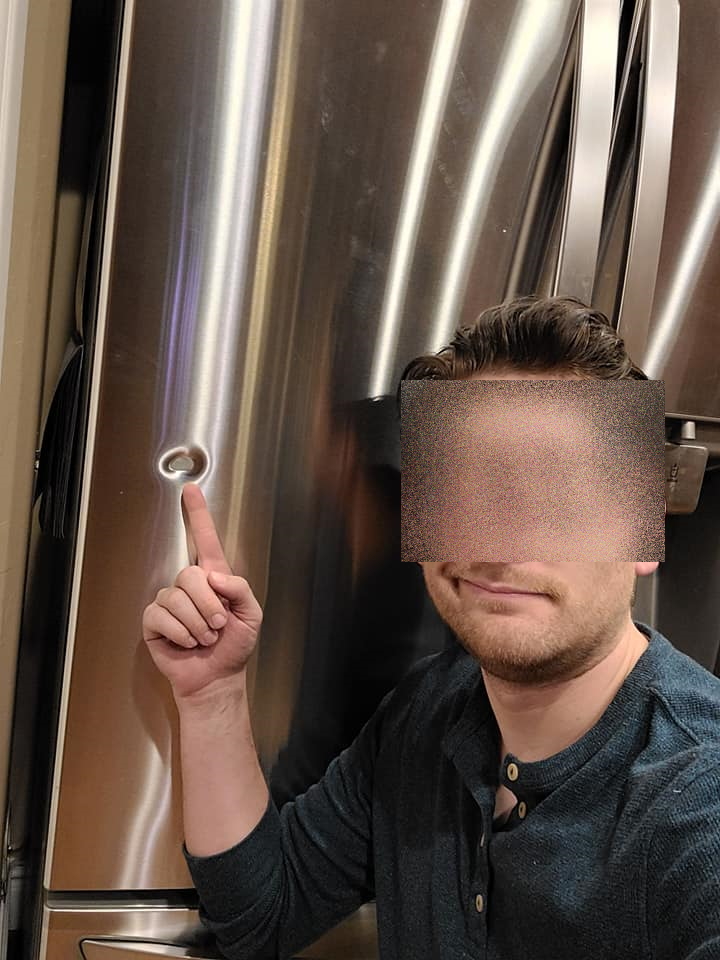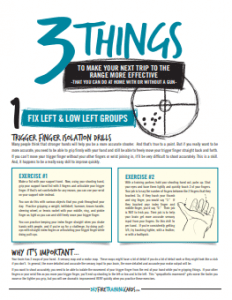The story I’m going to share with you today could have been bad…VERY bad.
A shooter in a group I’m a part of posted a picture of the aftermath of a negligent discharge that he had and some of the damage that happened. (Yes…he gave me permission to use his picture, but I still blurred it for him.)

So…how did this happen?
What kind of damage did the bullet do?
How effective was the fridge at stopping the bullet?
And how can you do dry fire multiple times per week safely and avoid something like this happening to you?
We’re going to cover that right now…
Eric is a competitive shooter who’s taken hundreds of hours of classes and successfully done thousands of magazine and chamber checks.
As Eric said,
“I always follow the layers of systems to be safe.
But this time I apparently didn’t.
I’m unclear on whether I missed clearing from a magazine or a chamber, but I “saw without seeing.” I’ve been so used to seeing nothing there, that this time I fooled myself into seeing nothing at all.
Fortunately I followed all other safety protocols and only killed my fridge.
All I expected was the familiar click while using the Mantis, but I got an enormous bang reverberating around my kitchen. Smoke hung in the air, and my jaw lay on the floor. I was in shock.
I found that a 9mm HP round had penetrated the stainless steel door on the fridge, punctured through the side wall of the fridge, pierced the wall into the pantry and didn’t stop till it was absorbed by my home brick exterior wall. (A lesson in itself.)
I was sure id followed the process correctly. I checked the magazines, the chamber, and was careful to remove ammo from the room. I had to watch my home interior security footage to accept that i’d somehow screwed up.
I had a heck of a time explaining it to my wife.”
I’m just glad Eric, his wife, and his neighbors were unharmed.
How does something like this happen?
It’s a “feature” of our mind that fills in gaps with what the mind expects to see, rather than what is actually there. In this case, Eric thought he saw an empty chamber when, in fact, there was a round in the chamber that didn’t eject out properly.
It could have been an issue with his ejector…it could have been because he didn’t rack the slide far enough…we just don’t know.
And, to the extent that we can, we need to plan for the unknown when we’re doing dry fire…keeping things safe without the process being so overwhelming that we don’t do it.
Let’s start with a definition…Dry fire is the manipulation of a firearm or training device without any live ammo present. By definition, if there is ammo present, it is not dry fire and therefore it is impossible to have a negligent discharge when doing dry fire
So, besides parsing phrases and identifying issues that only occur on movie sets, how do we make our own dry fire safer?
There are a couple of routes…the more expensive route is to use a dedicated laser trainer, airsoft training replica or CO2 training replica.
I’m about to put in an order for T4E paintball trainers. If you want a Glock, M&P, H&K VP9, or Walther P99, let me know. For more info, checkout https://DryFireTrainingCards.com/T4E
For laser trainers, I recommend the SIRT and you can get them, with training, for a screaming-good price >HERE< They’re $237 for the SIRT, spare mag, padded carry-bag, AND training.
The cheaper and easier route is to use Dry Fire Cord.
With Dry Fire Cord, (with the pistol pointed in a safe direction) you simply remove the magazine from the pistol, lock the slide to the rear, and remove all live ammo from the training area.
Then, insert the long end of the dry fire cord into the chamber and push it until the quad-chamfered aircraft grade aluminum barrel block is in the chamber and the long end is sticking out the muzzle.
Now, your chamber is blocked by stainless steel and you’ve got a visual indicator that the chamber is blocked.
If you want to do old-school dry fire with a “click” every time you press the trigger, push the tail down into the magazine well, release the slide forward, and proceed with your dry fire into a backstop capable of safely containing a negligent discharge.
If you want to do multi-shot dry fire sequences with a striker fired pistol, improve your ability to call your shots, know the correct firmness to grip with, and know how quickly you can run the trigger, then stick the tail out of the ejection port, ride the slide forward until it hits the cord, and now you’ve got a resetting trigger for dry fire without the distracting “click.” Even though dry fire cord blocks the chamber, you still want to use a backstop capable of containing a negligent discharge.
What about snap caps?
Snap caps have a place in training–specifically for revolvers and a lot of long gun applications, but it’s too easy to get complacent with snap caps and stack them on top of a live round in a pistol magazine. In addition, it’s much more difficult to convince the brain to transfer over the practice you do in dry fire to live fire when you’re racking the slide between each rep. It’s definitely not impossible, but it is more difficult.
With dry fire cord, you’ve got proof-positive that there is no round in the chamber AND that the chamber is blocked so that no live round can be introduced.
Want some? Of course you do…>Here’s where you can get some Dry Fire Cords for yourself
Thoughts? Questions? Fire away by commenting below:


1 Comment
BJI
October 22, 2021The Hollywood veteran accidentally shot and killed a cinematographer while filming a movie in Sante Fe, New Mexico. During filming, Baldwin was required to fire a gun loaded with blanks. As it turns out, the gun discharged either shrapnel or a bullet, killing 42-year-old Halyna Hutchins and injuring the film’s director, Joel Souza.
Leave A Response